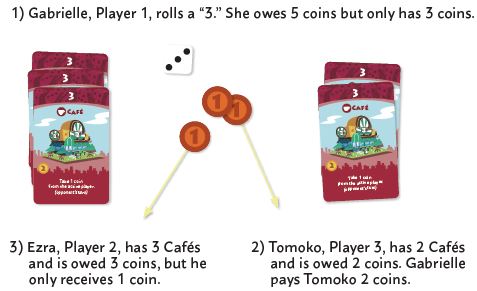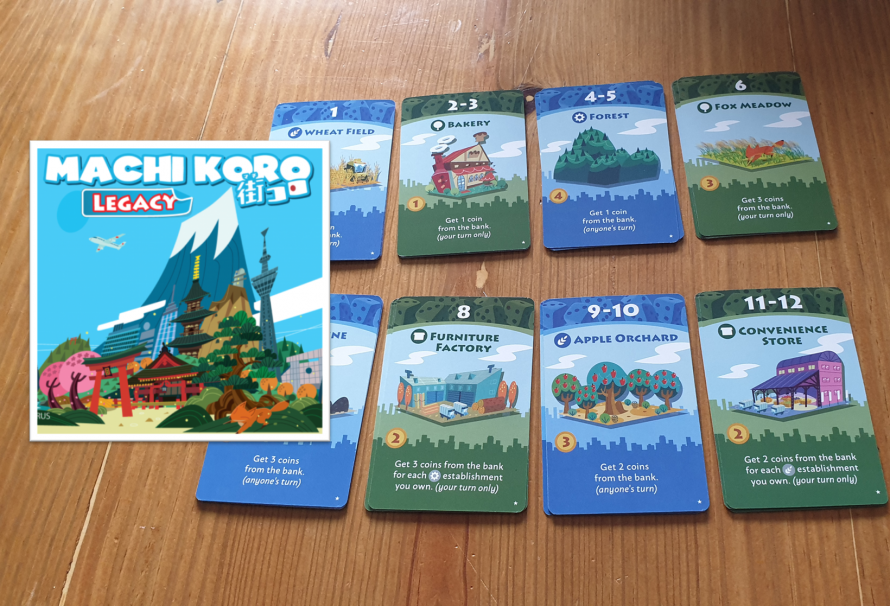Machi Koro Legacy
Machi Koro Legacy features a ten-game series that tells a complete story set in the world of Machi Koro in which player choices create a unique gameplay experience. — description from the publisher. Machi Koro Legacy features a ten-game series that tells a complete story set in the world of Machi Koro in which player choices create a unique gameplay experience. Machi Koro received multiple awards upon its release, and has received two major expansions. A standalone game based on the same mechanics, Machi Koro Bright Lights, Big City, was released in 2016, and a legacy variant was released in 2019. Oct 27, 2019 In Machi Koro Legacy, players take on the role of mayors competing to build the most attractive town on the Island of Machi Koro. During each game, every mayor is vying for the title of Best Mayor and must also work with the other mayors to build a landmark on the island.
Machi Koro Legacy is the brand new edition of Pandasaurus Games’ dice rolling family board game. Designed by Rob Daviau (one of the people behind Pandemic Legacy), JR Honeycutt and Masao Suganuma, the game sees 2 – 4 players building up a town. Across 10 linked games players will spend 30 minutes at a time earning coins, building landmarks and unlocking new content. The legacy treatment on other titles has resulted in some amazing experiences. However, does Machi Koro suit the changes? Let’s find out!
The core experience is the same as the original game. Players start with only 3 coins to their name and some lacklustre buildings. Each building type has a value of 1 – 12 assigned to it, as well as something that occurs. The effect can range from earning coins only when you roll, or on an opponent’s turn, through to stealing coins from another player. On a player’s turn they roll the dice or just one die. All players then use that number to activate cards of that value, following the Your Turn/Opponent’s Turn limitations.
The active player only is then able to either purchase a new establishment card to add to their tableau or a landmark. Increasing your tableau is a great way to earn more when specific numbers are rolled. It is also useful to spread your luck. By having more numbers the chance one of the values you want comes up increases. As a rough rule the numbers about 7 have higher coin returns. Therefore players will often start off rolling a die to trigger low cards but using coins to buy 7 – 12 valued cards before rolling both dice on their turns.
Each game players have access to four landmarks. Landmarks can be built by all players, so there isn’t a rush for individual landmarks, unlike the establishment cards which can run out. However, the game is instantly won by the player that builds the set of four landmarks. As far as the basic game goes this is the end of the gameplay. This is not just the basic game though and at the end of each game the legacy aspect of Machi Koro Legacy comes into effect.
Without giving away specific content this will see new cards come into play, others leave play and often includes a player choice. This is where winning has an instant benefit, throughout the experience. New establishment cards often have two sides to them. As a generic example, one side may be earning coins on your turn, with the other side about taking coins from an opponent. The winner marks the side of the cards that they wish to enter play. If you’re an aggressive player that loves to steal coins, or hates this aspect, by winning you can somewhat impact what becomes available. This is certainly not the only way the game changes, with new landmarks and buildings the tip of the iceberg. For the specifics you’ll have to play to discover them.

Perhaps it is the competitive nature of the game or the much shorter game length. It could be the way the game evolves with the changes sometimes straight swaps or simple additions. There are a few potential reasons, regardless of which, there is never an attachment grown between players and their town. Even after the 10th game each town can be identical, with the opportunity for personal choice impacting the town left to the individual games. This does however allow Machi Koro Legacy to be played beyond the final story game.
A loose narrative ties the games together, giving a slight meaning to why new components, elements or mechanisms have been introduced. It may not be possible to create a masterpiece across the handful of cards used to develop the story. Nevertheless, other legacy games such as Pandemic Legacy Season 1 managed something vastly more compelling. It can be easily forgotten and even skipped, with only the new rules introduced needing to be read aloud.
The components of the game are mostly secret at the offset of the 10 game campaign. With 3 large decks and 6 boxes of content to be slowly unveiled, players start with only player boards, dice, coins and a basic deck of cards. What players will start out with is what they would find in the original Machi Koro and nothing more. Progressing through the deck more cards of the same strong production quality will be revealed. Each card is clearly laid out, with a minor use of icons and text, beneath almost cute artwork. Being all about cards and dice, the cards themselves are certainly a strength of Machi Koro Legacy.
As with any game where new things are unveiled there is an excitement caused by opening boxes and going through the legacy decks. The unknown of what’s to come plays a big part in this. Though some content from the large boxes did make us question the sizing – with plenty of air in the box with the new component. Regardless of the reasonings for the new elements to the game it does result in each game feeling different, with a constant stream of new content. Each game is somewhat fresh with landmarks only being around for a few games and different objectives coming into play.
While the rulebook doesn’t suggest it, new players may want to play a couple of pre-Legacy games. It is far from compulsory as the game doesn’t drastically shift with changes after only one game. That being said, having played the original the knowledge of how the game plays helped us hit the ground running. Even one game would be enough, just so everyone can learn before winning or losing the first legacy game.

Machi Koro shows that more games could work with the legacy treatment. In this case, the story is lacking and some of the contents were underwhelming. However, the fact that each game in the 10 games is slightly different from the last, without straying from the core Machi Koro experience, is a great strength. Plus, players are left with a playable title at the end, to keep on enjoying. One sign that it does enough is that once equipped with this post legacy version there is little draw to ever return to the original. If you’re a fan of Machi Koro then this could be a legacy game for you to get to that post campaign version, it just isn’t a totally inspiring journey past the experience of unlocking content.
(Editor’s Note: Machi Koro Legacy was provided to us by Asmodee for the review. The game is currently available from local board game stores, find your local store here.)
Machi Koro Legacy is an engine-building game where players try to build up their city and construct the most Landmarks. Just like the original Machi Koro, players will start with almost no cards, then slowly build up their collection of establishments. With it being a legacy game, players can expect to make changes and lasting additions to their humble hamlets. So is it a hit, or not quite the kind of town you wanna visit? Read on, prospective Mayors!
Review
In the original Machi Koro, on each player’s turn they roll one or both dice, then activate any buildings that the sum of the die rolls equal. Blue buildings activate on anyone’s turn, green only activate for the active player on their turn, red buildings activate on opponent’s turns, and purple only on the active player’s turn. Usually the red and purple buildings are more of a “Take-that” style, letting players steal coins or other things from each other. After activating establishments players get to take one action, usually purchasing a new establishment or landmark.
It’s hard to talk about a legacy game without spoiling anything, so I’ll stick to mechanics or low-grade new things that you’d find out the second you opened the box. My first takeaway on opening the box was that they had greatly upgraded the coins from cardboard tokens to shiny plastic. They don’t have the weight of real coins, but they look like they would. Upgraded components are always a plus. The game designers also added a Community Landmark, that is far and away more expensive but also grants a serious boon to each game – and it changes each game. Players who purchase the Community Landmark put their flag on it and get the bonus immediately.
Besides the new Landmarks, players can look forward to adding new elements every game, including new establishments, new rules, new components, and new side-boards that after just a few games truly make Machi Koro Legacy look like a totally different game than the original. But the core loop of building up your city and getting more and more coins each turn is exactly the same as the original.
And that’s the problem. They added a lot of cool stuff that makes the game more fun, but they didn’t touch the main gameplay, which, while I like it, feels somewhat broken. You can still load up on as many Wheat Fields (Blue cards that activate on a 1 die roll) and then grab high-end Convenience Stores that activate on 11-12, and usually come out on top. It sounds high-risk high-reward, but three out of the first five games I won in a landslide with this strategy. Especially with a lower player count, you can potentially rake in 30-40 coins in one turn, an absurd amount.
Do not attempt to adjust your screen. This blurry photo is free of spoilers.

Machi Koro Legacy Rules
So who would Machi Koro Legacy appeal to? I would be hard-pressed to tell someone who didn’t like or only mildly enjoyed the original that they needed to run out and get it, since the legacy elements are more akin to body upgrades on a car with the same engine. Really this game is for someone who wanted to play Machi Koro but never bought it, and isn’t sure which game or set of expansions to get. This would be a good place to start for them, or for younger players or families who aren’t going to notice or care how easy it is to “game” the market. Veteran gamers or folks with limited shelf space may wish to look elsewhere.